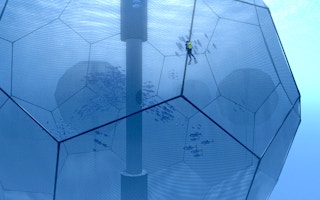Honolulu-based aquaculture company Hawaii Oceanic Technology recently received a Canadian patent for its open ocean farming system and the company is expecting to receive more from the European Union, Japan and Australia.
To continue reading, subscribe to Eco‑Business.
There's something for everyone. We offer a range of subscription plans.
- Access our stories and receive our Insights Weekly newsletter with the free EB Member plan.
- Unlock unlimited access to our content and archive with EB Circle.
- Publish your content with EB Premium.
Called the Oceansphere, the fishing system is an automated positioning and submersible open ocean platform that can grow yellow fin tuna and other pelagic species in an efficient and sustainable manner.
Currently, farmed fish provides half of all seafood consumed in the world. However, according to the United Nations Food Agriculture Organization (FAO), by 2030 an additional 62 million metric tons of seafood needs to be produced annually to meet the growing demand without depleting wild ocean stocks.
For Hawaii Oceanic Technology, the solution is in Oceansphere. Bill Spencer, the firm’s chief executive officer told Eco-Business, “The Oceansphere is designed to be environmentally responsible and economically sustainable.” It utilises proven off-the-shelf technologies that are well suited for large-scale deep ocean fish farming, which can satisfy future demands.
“The idea is to move fish farming off-land, away from industrialised near shore waters, bays and estuaries, out into the deep ocean, where it is a desert-like environment,” said Spencer. There, the farming system will be isolated and submerged so it will not be affected by surface activities like high winds or typhoons.
The Oceansphere is what the FAO deems as an aquaculture type of high technology closed system. It is a spherical cage with an exoskeleton made of neutrally buoyant materials with netting that is stronger than Kevlar. There is an automated buoy on the topside and this can hold 100 tons of fish feed that will automatically dispense to the fish contained inside the Oceansphere.
Spencer explained that employing this system, though not tethered to the ocean floor, enables natural processes to occur. This is better for the fish and it results in low food conversion rations, better health and faster growth.
However, the company founded in 2006 has yet to deploy an Oceansphere. Spencer detailed that they have been obtaining permits for the past seven years.
So far, the company has patents in the United States and the Philippines, aside from Canada.
In the US, they are still waiting on one final federal permit after a four-year process, said the CEO.
Hawaii Oceanic Technology does have a state permit in Hawaii, where they have a one-square-kilometre lease site off of the Kohala Coast, but not without receiving concerns and opposition from some members of the community.
The state, considering the comments, added stipulations to the firm’s permit. Spencer and company are required to test mercury releases in the ocean floor every quarter and to check the fish feeds for pollutants as well as the seawater after system cleaning.
Their permit allows them to deploy 12 Oceanspheres. These can produce 6,000 tons of yellow fin tuna per year. Spencer said, “More than 21,000 acres [or nearly 85,000 square metres] of land and mass quantities of fresh water would be needed to produce the same amount of beef protein … By farming protein in the vastness of the open ocean, we can be much more efficient than land-based protein production, use no land or fresh water and reduce the carbon footprint associated with traditional fishing methods, not to mention reducing impact on wild fish populations that are already severely stressed.”
Yellow fin tuna is, in fact, considered as fully exploited to depleted by the FAO, and the US is one of the main fishing countries.
The company emphasises, though, that their goal is not only to be a tuna farm, but also to license and sell their Oceansphere technology around the world. This is why they are eagerly waiting their patent grants. Spencer revealed, “The addressable market for open ocean mariculture technology is estimated to be US$75 billion.”
He added China is currently dominating the seafood farming market, producing 80 per cent of the world’s tilapia and 50 per cent of the world’s shrimp in land-based ponds and near brackish water land-based environments.
But he point out: “We are running out of fresh water and land. The ocean is the last place we can turn to efficiently produce protein without harming the environment.”
“The purpose of a patent is to show the world a better way to do something,” he said. “Imagine if China and the Philippines focused on farming seafood rather than fighting over hunting for seafood, imagine how this could stabilise an otherwise volatile region of the world.”










